|
Texas Feral Boar / Aoudad Sheep Hunt By Chuck Hawks with Bob Fleck and Jack Seeling  You know those hunting stories where the protagonist survives inclement conditions and dangerous wild animals, but perseveres and finally prevails in end, against the odds, by bagging a Boone and Crockett class trophy? The kind of hunt you read about in the print magazines every month? Well, this isn't one of those. Here at Guns and Shooting Online we have an editorial policy that requires us to tell the truth about what actually happens in the real world . . .. The Ranch and the Hunt In this case what happened was that Dr. Jim Clary, one of our contributing authors, told me about a "Hunt with Jeff" on the Double C Ranch in south-west Texas, where his daughter bagged a trophy red stag. Jeff Meyers is the owner of the Double C ranch outside of Crystal, Texas and the wildlife manager of the neighboring La Espuela and Lambert ranches, all of which offer hunting for native and exotic game species ranging in size from rabbits to elk. Together, these total some 22,000 acres teeming with game. Anyway, it sounded interesting. After some online research (www.huntingwithjeff.com), and an exchange of e-mails with the legendary Jeff Meyers, Guns and Shooting Online staff members Jack Seeling, Bob Fleck, and I booked a three day, two night (two full days of hunting) combination wild hog, aoudad sheep and varmint hunt at the Double C Ranch in early June. Each hunter would be allowed to shoot one aoudad, three feral boar, and unlimited varmints. Frankly, there are plenty of varmints much closer to home, so none of us saw this as a varmint hunt or brought a varmint rifle. Guns, Scopes and Ammunition Part of the fun of going on any hunt is the preparation and, being the worst sort of gun nuts, we meticulously prepared our rifles and practiced for the hunt. The primary consideration was that we needed rifles with adequate punch for a large feral hog (potentially 250 pounds plus) at close range and a sufficiently flat trajectory to engage a sheep at any reasonable range at which it might be found. Jack chose his Weatherby SUB-MOA stainless in .270 Winchester and Federal's 150 grain Fusion factory load. This rifle wears a new Simmons Pro Hunter Master Series 3-10x44mm scope in a Leupold base and rings. Bob prepared his Weatherby Mark V in .270 Wby. Mag. and his Custom Mauser 98 in .358 Winchester; the latter wears a 2.5x20mm Bushnell Banner scope in a Leupold mount. And I, being indecisive, worked with three rifles, my Winchester Model 70 Featherweight in 6.5x55, Custom Husqvarna in 7x57, and 7mm Rem. Mag. Weatherby Vanguard VGX Deluxe with its Weaver Grand Slam 3-10x40mm scope in a Leupold mount.All of these rifles are bolt action repeaters. They were carefully zeroed to take advantage of their maximum point blank range (+/- 3"), which means sighted-in to hit between 2.5" and 3" high at 100 yards. Bob and I procrastinated until the last minute (well, actually the last couple of days) before finally selecting our rifles for the hunt. Bob went with his Larry Brace built custom .358 shooting Winchester Super-X 200 grain Silvertip factory loads, and I ultimately chose my 7mm Rem. Magnum shooting handloads using the 154 grain Hornady Interlock Spire Point bullet at a MV of 3000 fps. Travel Our route from Eugene, Oregon to the Double C Ranch was somewhat circuitous. We left home around 7:00 PM (PDT) on Monday. First, we left drove two hours up I-5 to Portland and PDX. Then, after the usual airport hassle--amplified by checking guns and ammunition as luggage--caught a Continental 757 jet at 11:55 PM bound for Houston (flight time something under 5 hours). The airplane was clean and nearly new, a plus; the seats were narrower and harder than most commuter airline seats, a definite minus on a flight of that duration. Then we waited an hour and a half at Houston, changed planes, and boarded a Continental 737 jet bound for San Antonio, arriving there about 9:00 AM (CDT) on Tuesday morning. There we rented a car, actually a Saturn SUV, big enough for three men plus three gun cases and our personal luggage (which had arrived in good order) from the nice folks at Hertz. We promptly got lost in San Antonio, stopped for breakfast at a "Jim's" coffee shop, got lost again and wasted about an hour trying to find the correct route out of SA. Finally we got headed southwest on I-35 in the general direction of Crystal City, and arrived at the Double C Ranch about 3:00 PM. Arrival and Orientation At the ranch we were greeted by Rudy, who was to guide Bob and Jack for the next three days, and Shane (the "Super Guide"), who was to be my guide. Shane Abbott is in his early 20's and a recent graduate of Murry State University, KY with a degree in Wildlife Biology. He had recently moved to Texas from his hometown of Mount Vernon, Illinois to accept a position with Jeff. Despite his youth, Shane has been hunting for 14 years and proved to be adept at spotting game in the heavy cover in which we hunted. 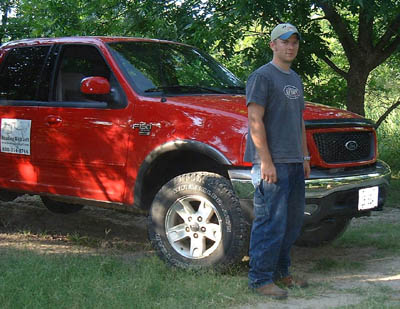 I had never previously visited South Texas, and in my mind I expected to find dry sagebrush flats and fairly open country. Instead, the Double C ranch and environs evidenced plenty of water. The land was covered with an eclectic combination of deciduous trees, heavy undergrowth, and patches of prickly pear cactus. Everything was green and growing despite the high ambient temperatures, which hit highs of 98-99 degrees F. in the daytime and lows of about 73 degrees at night during our stay. That meant that the over night low in South Texas was about the same as the daily high temperature this time of year in Western Oregon, where I live. Naturally, the guides were interested in seeing us shoot, and we needed to check our rifles to insure that the airline luggage handlers had not managed to change their point of aim, so a trip to the ranch's 100 yard rifle range was the first order of business. As it turned out, all was well with the rifles and we managed to pass the bench rest shooting test under the watchful eyes of Rudy and Shane. At the range we were advised to adjust our scopes to hit dead-on at 100 yards, as our shots would generally be taken from blinds at ranges between 50 and 100 yards. I flatly refused that suggestion on the grounds that my rifle had been carefully prepared, and sighting a 7mm Magnum for 100 yards makes no sense at all. Why tote a flat-shooting, long range rifle and then set it up like a .44 Magnum revolver? Shot Selection That conversation led to instructions to shoot feral hogs in the head, right behind the ear. Now, the fact is that I detest head shots. Animals move their heads constantly, even when standing still, making head shots very risky even if otherwise perfectly executed. If you cut the spinal cord where it enters the brain (with a bullet behind the ear), or get lucky and put a bullet through the brain, you've got an instant kill. But if you don't, you are almost certain to have a problem. The animal's central nervous system is a small target and the slightest miscue means an animal with a broken jaw, or blinded, or wounded in some other way. Practically nothing in the head/upper neck area, except the central nervous system, is immediately vital to life. Animals wounded in the head or neck area almost always escape to die a miserable death from starvation or predation. I quietly suggested that if stopping the animal was a priority a shoulder shot, angled to break both shoulders, would anchor the animal, kill quickly, and offered a much easier target. The heart/lung area is an even bigger target and a sure kill, but may allow the animal to run a short distance before expiring. The latter is ideal for non-dangerous game as it wastes practically no meat that is ordinarily eaten. But the guides were adamant about their suggested shot placement. We reluctantly agreed to attempt to follow their instructions, and that decision came back to bite us. Shane told me later that some of their clients had never previously hunted anything in their lives, and sometimes had never even fired a gun. These inexperienced hunters frequently had no idea where an animal's shoulder, heart, lungs or other vital organs were located. Often they could barely tell the head of a hog from the rump. The guides therefore told them to shoot for the head in order to minimize the number of gut and rump shot animals. Moving Right Along After our visit to the range we had time to take a short nap (having had no sleep at all since Sunday night), and then catch dinner in the ranch dining room at 6:00 PM. (Cheese enchiladas, rice, beans, chips, and plenty of coffee--very good!) Immediately after chow we piled into pick-up trucks and left for the evening hunt. Such are the demands placed on us outdoor media types; we're supposed to get it done on a gallon of coffee and practically no sleep, which is not always conducive to the best shooting! In this case it didn't matter, for although we saw plenty of game that night, none of us chose to take a shot. Perhaps this would be a good time for a brief explanation of hunting on a Texas ranch, or at least on the Double C Ranch. Texas Ranch Hunting Due to the mid day heat, when the animals sensibly lay in the shade of thick vegetation and are not moving around, hunting is generally confined to the early morning and late evening hours. We were usually taken to our stands for the morning hunt about 6:00 AM and picked-up again around 9:00 AM. In the evening we went out around 6:00 PM and were picked-up after dark, around 9:00 PM. A full breakfast was served at the ranch after the morning hunt and dinner was served before leaving for the evening hunt. All hunting/shooting is done from prepared stands. These are sort of like man-size doghouses with horizontal rectangular windows opening on three sides and a hinged door with a fourth shooting window on the back side. These little shacks are occasionally sitting on the ground, but more typically elevated and reached by a seven to ten step ladder. Inside are a chair or two and sometimes a shelf for your water bottle, binoculars or other accessories. The fancier stands are carpeted to minimize noise. My first stand was just nailed together from rough plywood with a corrugated tin roof and sat directly on the ground, but the others I occupied were elevated, made of fiberglass, and actually pretty plush. Shane told me that there were over 60 stands on the 22,000 acres of land to which Jeff controlled the hunting rights. 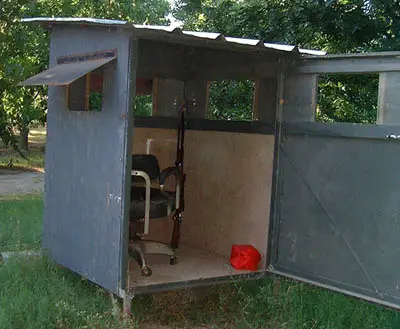 Still-hunting (stalking), my preferred hunting method, was not permitted. The problem is that with so many stands, some in fairly close proximity to each other and possibly occupied by an inexperienced hunter who might become excited and shoot at anything that moves, the risk of an accident is considered to be too great to allow hunters to pussy foot around on the ground. Too bad, because it would be a lot more fun, not to mention more sporting, to stalk the animals in their habitat rather than to simply blast them from a stand. Not being used to the June daytime heat of South Texas, I habitually left the door of my blinds open for the extra ventilation. This did not seem to disturb the animals that I saw, who steadfastly ignored the blind, and me. When I experimented by intentionally making a little noise inside the blind they continued to ignore me. Nor did my scent seem to bother the animals, even when carried directly from my position to theirs by the wind. Only mosquitoes and flies seemed to have any interest in me. Being ignored by big game animals in close proximity to my position was kind of eerie, and very different from hunting big game in the Pacific Northwest. The blinds were usually situated in view of a feeder or feed lot and near a pond or other source of water. Access to the blind was by means of a dirt road that was usually salted with corn to attract animals into the road. This kind of thing would be totally illegal in Oregon, as would shooting after dark, but it is legal in Texas, where feral hogs of either sex may be hunted 24/7/365 and the ranches can make up their own rules regarding their exotic game animals. First Evening, First Hunt That first night on stand provided what was to be my only good opportunity to shoot a decent feral hog. That particular stand overlooked an automated feeder (no kidding--see photo) 62 paces distant, and water had pooled from leaky pipes directly behind the stand that irrigated a pecan tree orchard. Hogs like to eat, and they have no sweat glands, so they are typically found near food and water. I was in the right place. 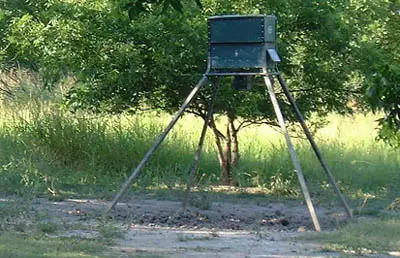 Photo by Chuck Hawks. About dusk, when there was still plenty of light by which to shoot, a couple of native Texas whitetail deer appeared on the access road, but never approached closer than about 100 yards to my stand. Shortly later, one male and two female feral hogs accompanied by about four little piglets sauntered out of the brush and trees and congregated at the feeder, where they proceeded to scarf down corn. (How do you tell a male pig from a female pig? Look for male genitals.) I watched the male through my scope off and on for the next half-hour, and I could have killed him many times over. He sported visible tusks perhaps 2.5 inches long, and probably weighed at least 150 pounds on the hoof; a guess based on the size of hogs bagged by other hunters that I saw weighed at the ranch. The largest hog taken during my stay scaled about 95 pounds, so this was the largest boar I was to see but, of course, I didn't know that at the time. Our hunting package allowed each of us to take three feral hogs and one aoudad sheep, but I had mentally limited myself to shooting one hog. And I really wanted one over 200 pounds, so I held my fire. Well after it was too dark to see enough to shoot, Shane returned with his pickup truck and collected me for the return to the ranch. By the time we got back there were a couple of medium size hogs hanging in the cleaning barn, harvested by other hunting parties. Most of the hogs that we saw during our stay weighed 50-75 pounds. Back at the ranch I learned that Jim and Bob had also refrained from shooting. It had been a long day, and we were happy to turn in for the night. Second Day, Second Hunt The next morning it was up at 5:00 AM for a quick cup of coffee and a sweet roll, then off to a different stand for the morning hunt. I learned that the Texas feral hogs are nocturnal, usually disappearing into the thick brush and trees well before sunrise and not usually reappearing until well after sundown. My experience the previous night was unusual, as the hogs had appeared shortly after sundown, while the sky was gray and there was still plenty of light to determine sex and estimate size. That was a luxury I was not to have again. Sex determination was important because it was spring and I figured that most of the mature females would have piglets. Although it is legal to shoot female feral hogs year around in Texas, and no one at the ranch seemed to care one way or the other, to me killing a mother pig and letting the babies starve or be taken by predators would be beneath contempt. No way would I want to be responsible for that. That morning I saw a number of whitetail deer, fallow deer, a red stag, plus Hawaiian, Corsican, and four-horned sheep, but no aoudad at all and no hogs after it was light enough to clearly identify a target and shoot. About 9:00 AM Shane and his truck reappeared and ferried me back to the ranch to rejoin my friends and the other guests for a full breakfast. One thing for sure, you eat well at the Double C Ranch. On the drive back to the ranch, Shane pointed out a variety of exotic game animals, including spectacularly horned oryx and playful black buck antelope. 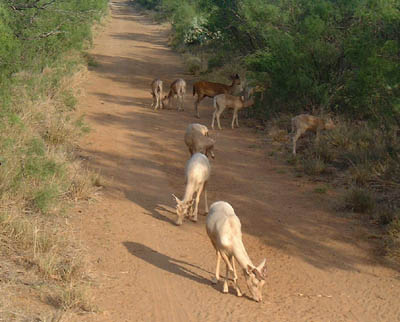 Bob and I had not fired a shot, but Jack had. Having a chance at a decent hog, he tried for the recommended head shot at about 100 yards. The animal dropped instantly and didn't even twitch, as is supposed to happen when a Guns and Shooting Online staffer shoots. But, unfortunately, as Jack was descending the ladder from his blind, the hog recovered its feet and took off into the thick vegetation. There was no blood trail to follow after the first few yards, and despite Jack (and later Bob and Rudy's) best efforts, the animal disappeared and was not recovered. After breakfast that morning the Guns and Shooting Online contingent had a conference and decided three things: 1) No more messing around with head shots, particularly in dim light. Jack's hog had been knocked cold by the impact of his bullet, just as if it had taken a clean punch from Muhammad Ali. But, unbeknownst to Jack, the central nervous system had not been hit, allowing the boar to regain consciousness and escape. 2) Shoot feral hogs twice. If Jack had driven a second bullet through its chest while the animal was on the ground it never would have gotten up. 3) Go for a shoulder shot, attempting to break both shoulders if possible. This will waste some meat, but we weren't on a meat hunt, anyway, and it will anchor the animal. Shoulder shots usually take out the lungs, too, and are thus quickly fatal. Following our little council of war I spent the rest of the day relaxing and reading. Other guests partook of the horseback riding, fishing (we didn't know enough to bring fishing tackle), bird and animal watching, and informal clay target shooting activities offered at the ranch. Others enjoyed the hot tub or swimming pool. Jack and Bob spent some time at the "Tiki Hut" covered bar next to the pool, sipping soft drinks and listening to Jimmy Buffett songs. Second Day, Third Hunt That evening found me on my most productive stand of the trip. It was another elevated blind with a feed lot on one side and a good size pond on the other. The range across the feed lot was about 200 yards, and the range to the opposite shore of the pond was maybe a little over 100 yards. There were a half dozen five-point elk standing around the feed lot when we drove up, and they paid us no attention at all. 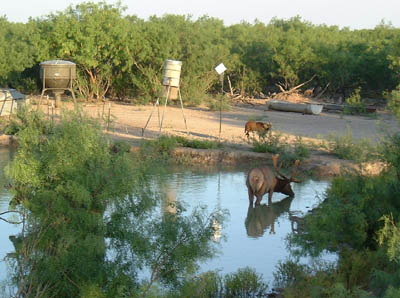 Photo by Chuck Hawks. I couldn't believe it, and informed Shane that during the hunting season my native Western Oregon Roosevelt elk behaved nothing like these transplanted Texas Rocky Mountain elk. Being from Illinois, Shane had no experience with the wild Roosevelt elk of the Pacific Northwest. He did tell me that the lovely spotted Axis deer and aoudad sheep were the wariest and hardest animals on the ranch to collect. On this stand I observed a constant stream of native whitetail deer, fallow deer, elk, black buck, Corsican sheep, Hawaiian sheep, Texas Dahl sheep, mouflon sheep, and four-horned sheep (strange creatures to be sure) migrating from the feed lot to the pond and back. Every kind of sheep in Texas except the aoudad that I wanted. I even observed a skunk beneath the trees next to my stand. 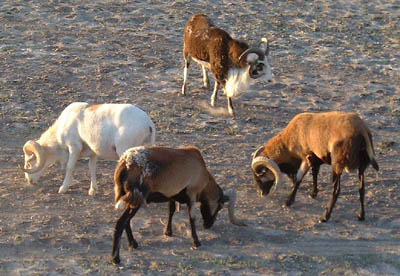 Photo by Chuck Hawks. I was very tempted to shoot a nice, full curl, Texas Dahl ram that paraded slowly past my stand at a range of about 50 yards. But Dahl sheep were not included in our hunting package, and the high surcharge commanded by these trophies stayed my hand. Instead, I took a few photos. Well after dark perhaps a dozen feral hogs arrived, cutting across directly under my stand. I could hear them, and see shapes moving through the brush in the darkness. But no way would I shoot at a vague silhouette in the dark. The Guns and Shooting Online contingent had done enough wounding for one trip, and the most important part of being a responsible hunter is knowing when not to shoot. That night I beat Bob and Jack back to the ranch. And while Jack had done no shooting, Bob had an opportunity at a medium size male hog standing at the edge of a pond and took the shot. His first bullet passed through the hog's chest from upper left to lower right and destroyed the creature's lungs, dropping it where it stood. Mindful of Jack's error that morning, Bob immediately put another, unnecessary as it turned out, bullet into the animal's chest as it lay on its side quartering toward him. This bullet entered the front of the chest and exited the animal's back near the spine. 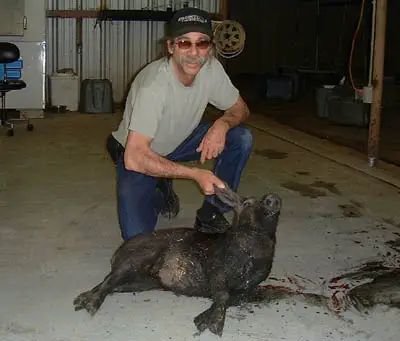 That pig weighed 71 pounds before being field dressed. After it had been skinned and cleaned the bullet holes in the carcass were obvious and impressive in size. Shoot a 71 pound animal with a .358 caliber elk rifle and the result is spectacular, in a grim sort of way. We spent the rest of the night talking, drinking beer and soft drinks, and playing pool in the ranch rec. room. They also had a giant 50" HDTV and lots of hunting/shooting games on tap that used laser rifles and pistols. Jack and our gracious and beautiful Hostess Brittany proved to be experts with the laser pistol, shooting high scores from the hip on everything from insects to elephants, while Jeff's lovely daughter (and Hostess) Carley kept us supplied with soft drinks and beer. 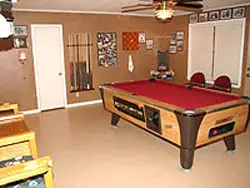 Jack summed up the Double C Ranch operation nicely when he observed that it was a great place for a wealthy person who, regardless of his or her experienced as a hunter, wanted to put a trophy head on the game room wall. Presumably that person would be willing to devote a weekend or even a week at what is basically a luxury resort to the project, but not willing or able to spend two or three weeks humping around Africa, Alaska or the Yukon to maybe get a chance at a trophy. Third Morning, Last Hunt Bob's kill effectively ended our Texas hunt. Our last morning found me on what was to be my least productive stand, overlooking a "T" junction of two roads. I saw a few fallow deer, a couple of whitetail deer, an elk, and a number of black buck, all between 75 and 150 yards distant. No aoudad and no feral boar were present. In fact, I had not seen an aoudad the entire time. Neither did anyone else. The one exciting moment of that last morning was when a beautiful axis buck stepped into the road to the right of my stand at maybe 100 yards. He was at least half again as big as the largest whitetail present, with very wide spread antlers. Measuring as carefully as I could against the duplex reticle in my Weaver Grand Slam scope, I estimated the main beam of his antlers to be about 36" from base to tip. If so, he was a great specimen. I was told that a 30" main beam was considered trophy class. Once again I was tempted to shoot, but the $3500 charged by the ranch for such an animal dissuaded me. We're gonna need a lot more Guns and Shooting Online members before I can afford that sort of trophy! After our last morning hunt came breakfast, the chore of packing, the long drive back to San Antonio and the much longer flight home. Summary and Final Comments A full service, 3-day/2-night (2 full days of hunting) feral hog, aoudad, and varmint hunt at the Double C Ranch costs $600 per person, which includes accommodations and meals at the ranch, guide services, and even extras like bottled water, soft drinks, and beer. A hunt at the Double C Ranch is not cheap, but it is not unreasonable, either. The accommodations are good, roughly comparable to a 3-star hotel, and include room service. Everyone at the Double C Ranch is very friendly and helpful. Add airfare to the price of the hunt, plus the rental car and incidentals, including gratuities, and the total cost per person was probably about twice the retail price of the hunt. Even though I didn't fire my rifle in anger, I had a good time. I saw a lot of exotic game, the food and accommodations were great, and the staff at the ranch are super. (I never did meet the mysterious "Jeff," however, although I was told that he was around.) Regardless, Rudy, Shane the Super Guide, Brittany and Carley made us feel right at home throughout our stay at the Double C Ranch. Some might think that I wasted my time and money, since I didn't take a trophy. But hunting isn't just about harvesting an animal, and spending a thousand-plus dollars doesn't give me or anyone else the right to take a chancy shot and hope for the best. Like I said earlier, the most important part of being a responsible hunter is knowing when not to shoot, whatever the cost. |